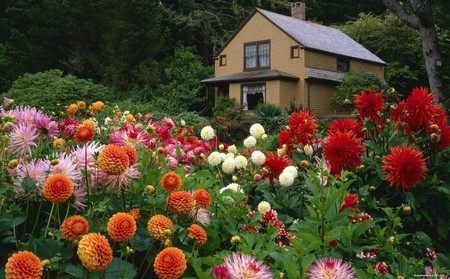Division is one of the easiest, most basic and cheapest methods of propagation. Large plant clumps are simply split up into several smaller ones — or in some instances small plandets are detached from the sides. Newcomers to gardening will be dealing in the main with clump-forming herbaceous and rock perennials, and naturalized bulbs.
Note
Only ever divide plants which are healthy.
After you have carried out a division, aim to move the new plants to a fresh part of the border, switching them round with different kinds of border plants. This is to prevent a build up of pests and diseases.

Most clump-forming perennials should be divided every three to five years as a matter of routine in a rejuvenation process, regardless of whether more plants are needed or not. Neglect in this respect leads to overcrowded, weak-stemmed plants with few and inferior flowers. Provided a reasonable standard of cultivation is maintained, and a few basic rules observed, healthy plants should remain in good condition indefinitely, when divided up at regular intervals.
DIVIDING CLUMP-FORMING HERBACEOUS BORDER AND ROCK PERENNIALS
Plants flowering in early spring are best dealt with in autumn. Otherwise the job can be tackled any time between mid-autumn and early spring, so long as plants are resting and the soil is neither frozen nor over wet.
Systematically working all round the clump, loosen with a garden fork, ease up and lift. Poke soil, small stones and weeds out from amongst the roots with a pointed stick. It is then very easy to pull young plants apart by hand. Just make sure each portion has some healthy roots and strong buds. Trim away any damaged roots and dead leaves before replanting the young, actively growing, outside portions of the clump. Always dispose of worn out pieces from the centre of the clump. And always work quickly so that the roots don’t dry out. Older neglected plants are more difficult to deal with, as very often their roots are well entangled. Using a spade, chop them up into reasonably sized portions, then deal with them as above and they will be easier to cope with next time they are lifted.
The majority of popular border and rock perennials are treated in this manner.
DIVIDING OFF PLANTLETS
Strawberries are increased by removing plandets. Keep up a succession of young plants by pegging down plandets into small pots of potting compost in early summer. Don’t pin down more than four plandets from any one healthy plant. Each stem/runner may carry several plandets: it is the one nearest the parent which is used. Cut off the portion of stem beyond the pegged down plantlet, along with any other surplus runners. Once the young plants are growing freely, they are severed and planted up in fresh ground.
DIVIDING UP NATURALIZED BULBS AND CORMS
Like herbaceous perennials, naturalized daffodils, narcissi, crocus and snowdrops need to be lifted and divided periodically, when they become overcrowded and flowering deteriorates.
In the case of daffodils, narcissi and crocus, gently fork up the clump after the foliage has died down. Separate the bulbs and corms and grade them for size. Put the largest to one side ready for planting in their flowering positions. The smaller ones need to be grown on for a few years, in an out-of-the-way spot, until they have made sufficient size to flower. Either replant the bulbs and corms immediately, giving the flowering-sized ones a bit of fresh ground and a bit more room, or alternatively dry them off and replant in autumn.

Snowdrops are different. Deal with them immediately they have finished flowering and are still carrying plenty of leaf. Split them up; they must be replanted without delay or suggestion of drying. Water in after planting.
Further Readings: